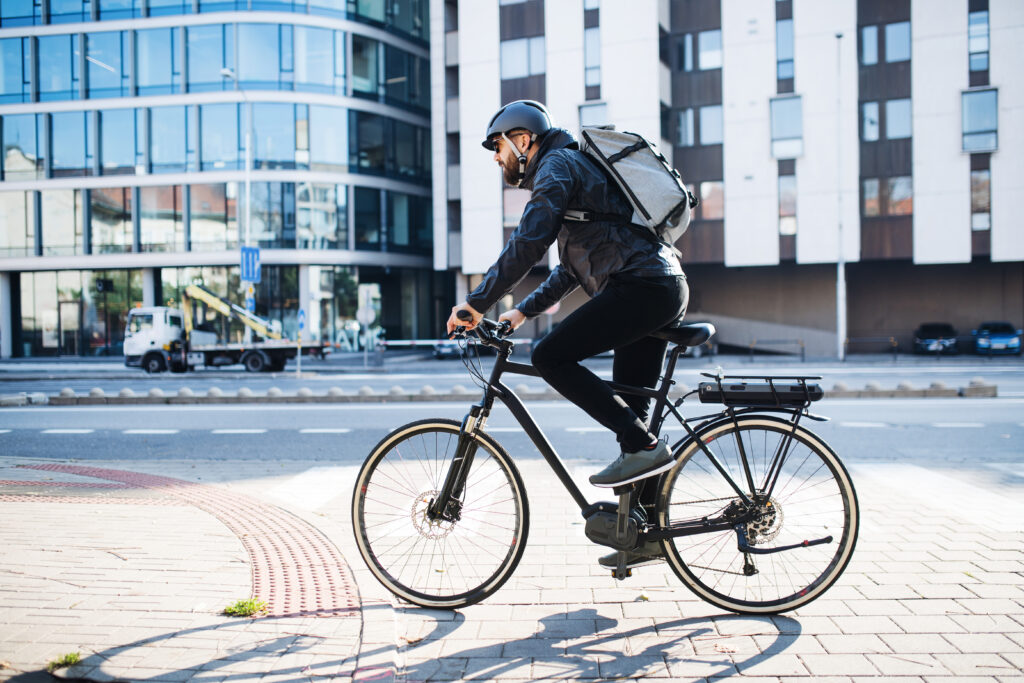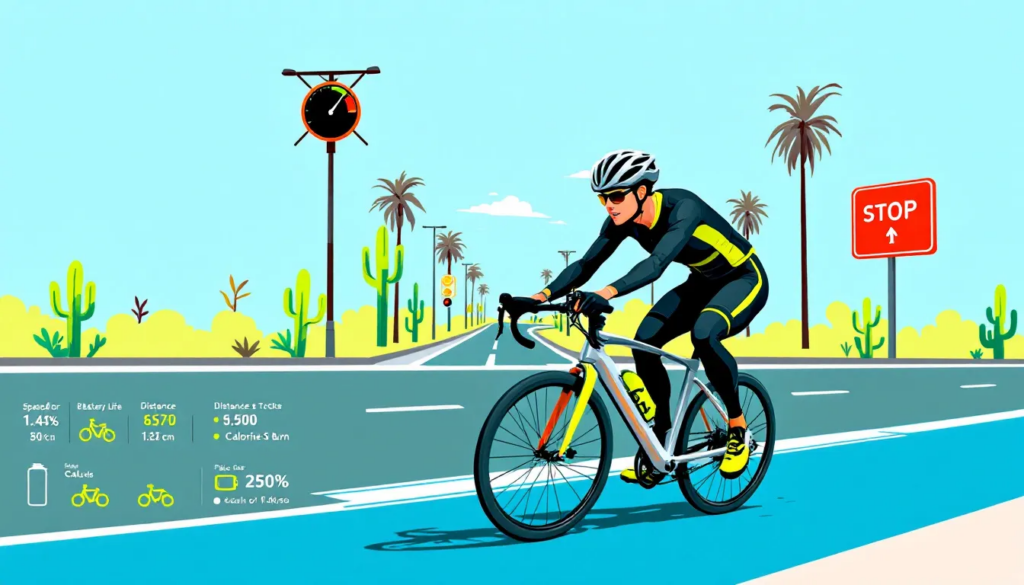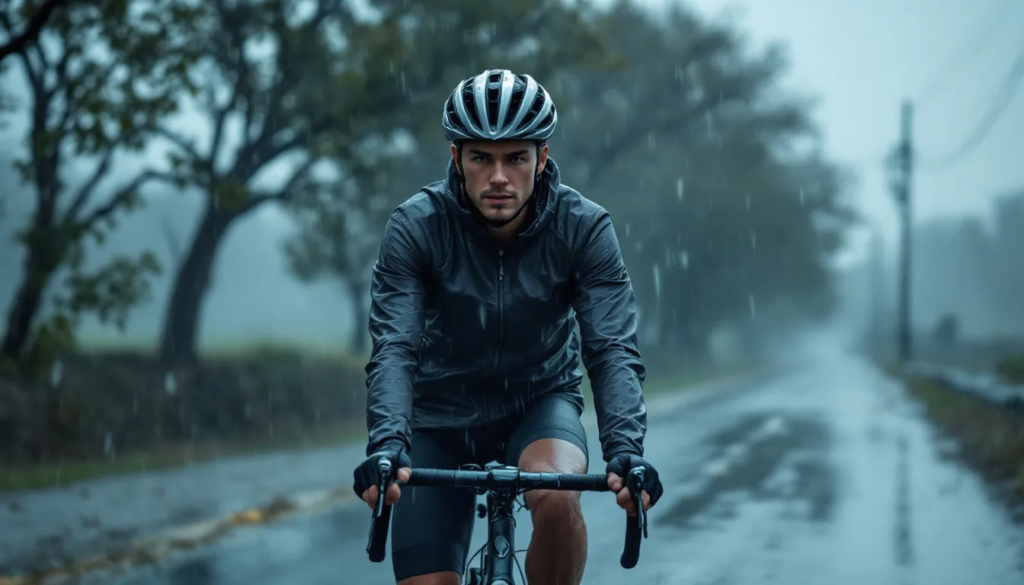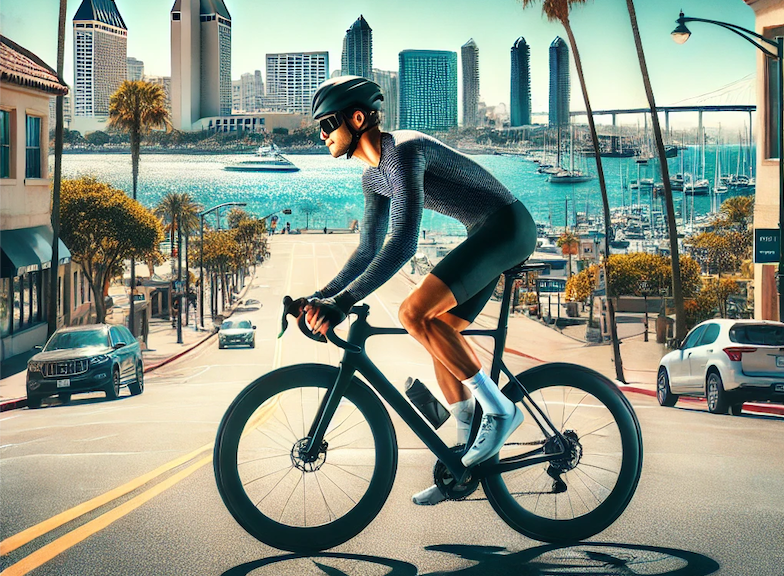Top Myths About Road Cyclists Debunked

Many myths about road cyclists create misunderstandings and safety issues. This article debunks the most common myths, providing clear explanations for better road sharing. Whether you’re a cyclist or a driver, this insight will improve your understanding. Key Takeaways Cyclists must follow the same traffic laws as motorists, including the ability to occupy the full lane when necessary for safety. While a minority of cyclists may disobey traffic rules, many adhere to them, and cyclists contribute to road maintenance through various taxes. Advancements like pedal assist bikes make long commutes feasible for cyclists, and properly designed bike lanes enhance safety in busy areas. Myth: Road Cyclists Should Always Stay to the Right One of the most common cycling myths is that road cyclists should always stay to the right, hugging the curb as closely as possible. This misconception stems from a misunderstanding of traffic laws and the practicalities of safe riding. Bicycles are often classified as vehicles, so cyclists must adhere to the same traffic laws as motorists. Cyclists must position themselves according to their speed and the traffic conditions. This often means riding to the right, but not always. For instance, if the lane is too narrow for a bicycle and a car to share side by side safely, cyclists are allowed to take up the entire lane for their safety. Moreover, at intersections, cyclists must yield if they do not have the right of way, just as motor vehicles do. When changing lanes, cyclists are required to yield to traffic in the traffic lane and car lanes they intend to occupy. This ensures that they integrate smoothly and safely into the flow of traffic. Understanding these rules helps both cyclists and motorists navigate roadways safely and efficiently, respecting each other’s rights and responsibilities. Myth: All Road Cyclists Run Red Lights A widespread myth suggests that all road cyclists run red lights, flagrantly disregarding traffic signals. This belief overlooks the responsible behavior of many cyclists who adhere to traffic rules just like other road users. This misconception likely arises from the visibility of the few who break the rules, casting a shadow over the entire cycling community. Most cyclists prioritize road safety and visibility, often positioning themselves in the middle of the street rather than sticking to bike lanes to avoid being unseen by motorists. This strategic positioning can sometimes be misinterpreted as rule-breaking when, in fact, it is a safety measure. Responsible cycling behavior is common, and many cyclists work hard to follow traffic laws and contribute to a safer road environment for everyone. Myth: Road Cyclists Don’t Pay Their Fair Share A common myth is that road cyclists do not pay their fair share for using public roads. This misconception ignores the fact that roadways are primarily funded by general taxation, not just user fees. In fact, only about 8% of roadway funding comes from user fees like gas taxes and registration fees, with the remaining 92% coming from general funds. Cyclists contribute to these general funds through various taxes, including property tax and sales tax. This means that even those who do not own a car still support the maintenance and construction of roads through state and local funding. Additionally, investments in bicycle infrastructure tend to create more local jobs compared to traditional road projects, providing both economic and social benefits. Moreover, active transportation options like cycling lead to broader social benefits, such as enhanced community interaction and reduced crime rates. By understanding these contributions, it becomes clear that cyclists do indeed pay their fair share and bring additional value to the community. Myth: Cycling on Busy Roads Is Too Dangerous The belief that cycling on busy roads is too dangerous deters many potential cyclists. However, properly designed bike lanes and protected bicycle lane paths significantly reduce the risk of accidents. Research shows that cyclist safety improves with the increase in adequate infrastructure and road infrastructure in urban areas. High-traffic locations with well-marked bike lanes are associated with lower injury rates compared to roads without dedicated cycling space. For instance, the installation of separated cycle tracks in roundabouts can lead to a substantial decrease in injury rates among cyclists. These infrastructure improvements make cycling a safer and more viable option, even in busy urban areas. Cyclists need to be aware of their surroundings and use strategies like signaling their intentions and merging into traffic lanes cautiously when necessary for safety. By adopting these practices, cyclists can navigate busy roads more safely and confidently. Myth: You Need Expensive Gear to Ride Safely Many believe that to ride safely, cyclists need to invest in expensive gear. This myth can discourage new cyclists from taking up the activity. In reality, safety can be achieved with budget-friendly options without compromising on protection or comfort. Quality safety equipment, such as helmets and lights, can be found at affordable prices. Reflective materials and lights are essential for visibility, and there are plenty of cost-effective options available. Cycling gloves, which provide protection and comfort, are another example of budget-friendly gear that can enhance the riding experience. Believing that only high-end gear ensures safety is a common cycling myth that needs to be debunked. Myth: Only Athletes Can Be Road Cyclists The idea that only elite athletes can be road cyclists is another myth that needs debunking. Cycling is an inclusive activity that welcomes people of all shapes, sizes, and fitness levels. Many everyday people enjoy cycling, not just elite athletes. There is no specific body type required to enjoy cycling; anyone can participate and benefit from this healthy activity. Cycling is increasingly recognized as a fitness activity suitable for individuals from all walks of life. Consistent riding can help build cycling fitness, and pedal assist bikes make longer trips feasible and enjoyable for many. This versatility shows that cycling can cater to individual preferences and needs, making it accessible to a wide audience. Myth: Road Cyclists Are a Menace to Other Road Users The idea that road cyclists and bicycle riders are
Distracted Driving and Cyclists: Risks and Safety Tips for Urban Riders

Distracted driving injures cyclists more often than you might think. With the rise of texting and other distractions, distracted driving injures cyclists, putting them at increasing risk. This article will cover the impact of distracted driving on cyclists, the common causes of these distractions, and essential safety tips for urban riders. Additionally, we will discuss the importance of bicycle safety through educational initiatives that teach essential traffic laws and safe riding practices. Key Takeaways Distracted driving significantly increases the risks of bicycle accidents, with cyclists being particularly vulnerable due to their lack of protection. Everyday activities such as phone use, eating, and adjusting the radio contribute to distracted driving, leading to various types of dangerous incidents involving cyclists. Infrastructure improvements, public awareness campaigns, and vigilant riding practices are crucial for enhancing cyclist safety against distracted driving. Understanding Distracted Driving Distracted driving is a serious issue that affects road safety, particularly for vulnerable road users like bicyclists. It is defined as any activity that diverts a driver’s attention away from the task of driving. Common distractions include: Using a cell phone or other electronic device while driving Eating or drinking while driving Talking to passengers or engaging in conversations with other drivers Adjusting the radio, climate control, or other vehicle settings Grooming or personal hygiene while driving Reading or looking at maps or other materials while driving Engaging in any other activity that takes a driver’s eyes off the road or hands off the wheel Distracted driving can lead to accidents, injuries, and fatalities. According to the National Highway Traffic Safety Administration (NHTSA), distracted driving was responsible for 3,308 deaths in motor vehicle crashes in 2022. Bicyclists are particularly vulnerable to distracted drivers due to their smaller footprint and less protective barrier compared to cars. This makes it crucial for drivers to maintain their focus on the road and avoid any activities that could divert their attention. The Impact of Distracted Driving on Cyclists Bicycle injuries and fatalities have become a pressing issue on American roads. In 2022, distracted driving claimed 3,308 lives, and cyclists are particularly vulnerable due to their smaller footprint and lack of protection. Traffic safety facts highlight that distracted driving is a leading cause of accidents, with severe consequences for all road users. The trend of fatalities among cyclists due to distracted driving is on the rise, making up an increasing share of cycling-related deaths, including distracted driving related fatalities. This isn’t just about numbers; these statistics represent real lives lost and families devastated by preventable accidents. The rise in distracted driving poses a severe threat to all road users, but cyclists bear the brunt of this danger. With 83.5% of bicycle fatalities from distracted driving being male in 2022, it’s clear that certain demographics are more at risk. Cyclists accounted for 3% of all deaths on roads that year, a sobering figure that underscores the need for immediate action. Distracted driving is a growing danger on the roads. It poses a significant threat to overall road safety. Cyclists must constantly be on high alert, as distracted drivers significantly increase the risk of accidents. Whether it’s due to texting, eating, or simply not paying attention, the chances of a collision escalate when a driver’s focus is anywhere but on the road. In urban areas with high traffic volume, this danger is amplified, making it crucial for cyclists to adopt defensive riding techniques and remain vigilant. Common Causes of Driver Distractions Distracted driving encompasses any activity that diverts a driver’s attention from driving. The National Highway Traffic Safety Administration (NHTSA) defines it as engaging in activities like using a technological device or other inattentive behaviors. One of the most notorious distractions is cell phone use, which accounts for 18.6% of distracted driving-related crashes. Texting, in particular, is exceedingly dangerous, as it can divert attention from the road for about five seconds, enough time to cover the length of a football field at 55 mph. Distracted driving laws aim to address these dangerous behaviors. Before: However, it’s not just cell phones that are the culprits. Everyday activities such as adjusting the radio, eating, drinking, and even personal grooming while driving fall under inattentive or careless driving. These activities might seem harmless but can lead to significant lapses in attention and increased reaction times, making it difficult to respond to sudden changes in traffic or the presence of cyclists. After: Everyday activities that contribute to inattentive or careless driving include: Adjusting the radio Eating Drinking Personal grooming These activities might seem harmless but can lead to significant lapses in attention and increased reaction times, making it difficult to respond to sudden changes in traffic or the presence of cyclists. The cognitive distractions are perhaps the most insidious. These occur when a driver’s mind wanders away from the task of driving. Daydreaming, being deep in thought, or dealing with emotional stress can all lead to a dangerous reduction in a driver’s attention. Recognizing these distractions highlights the importance of maintaining a focus on driving to prevent accidents. Types of Bicycle Accidents Involving Distracted Drivers The types of bicycle accidents involving distracted drivers are varied, each presenting unique dangers to cyclists. One common scenario is when distracted drivers fail to yield the right of way at intersections. Intersections are particularly hazardous for cyclists, as drivers may be preoccupied with their devices or other distractions, leading to catastrophic collisions. Bike paths are also relevant locations for accidents involving pedestrians and cyclists, contributing to a broader understanding of traffic safety. Analyzing crash data from the Fatality Analysis Reporting System (FARS) helps identify these critical areas. Another frequent type of accident occurs when drivers turn left into the path of a cyclist. This can happen when the driver is distracted and doesn’t see the cyclist approaching. Similarly, right-hand turns can be perilous, as drivers may ignore cyclists with the right of way and turn into their path. Distraction and reduced reaction time often cause these accidents, leading to severe consequences for cyclists. Another significant
Debunking Common Myths About Road Cycling

Debunking Myths About Road Cycling: 12 Common Misconceptions Road cycling is an exciting, rewarding, and healthy activity enjoyed by millions worldwide. However, many misconceptions prevent beginners from giving it a try. Whether it’s the belief that you need expensive gear, extreme endurance, or that cycling is unsafe, these myths can discourage potential cyclists from hitting the road. In this article, we’ll break down 12 of the most common road cycling misconceptions and provide factual, practical insights that can help you confidently start your cycling journey. 1. “Road Cycling Is Only for Professional Athletes” Myth: Many people believe road cycling is reserved for elite athletes who train for hours each day, compete in races, and wear professional gear. Reality: Road cycling is for everyone, regardless of fitness level, age, or experience. While professional cyclists dedicate years to training, the average cyclist, who trains five to eight hours per week, can enjoy cycling at their own pace, whether for fitness, commuting, or leisure. You don’t need to be in top physical condition to start cycling. Many beginners start with short rides and gradually build stamina. Road cycling is a fantastic way to improve cardiovascular health, burn calories, and reduce stress, even with just a few rides per week. ✅ Tip: If you’re a beginner, start with flat, easy routes and gradually increase distance and difficulty. Cycling apps like Strava and Komoot can help you track progress and find beginner-friendly paths. 2. “Anyone Can Ride Bikes” Myth: Bike riding is only for a specific group of people, such as the young, fit, or experienced. Reality: Contrary to popular belief, anyone can ride bikes, regardless of age, fitness level, or background. With the right equipment and a bit of practice, everyone can enjoy the benefits of cycling. Many cities have implemented bike-sharing programs and cycling infrastructure to encourage people of all ages and abilities to ride bikes. Whether you’re a seasoned cyclist or just starting out, bike riding is a great way to get exercise, reduce stress, and have fun. ✅ Tip: Don’t be intimidated by the idea of cycling. Start with short, easy rides and gradually build your confidence and skills. 2. “You Need Expensive Gear to Start Road Cycling” Myth: To enjoy road cycling, you must spend thousands of dollars on a high-end carbon fiber bike, aerodynamic gear, and professional-grade accessories. Reality: While professional cyclists invest in expensive equipment for performance gains, beginners can start with a simple, well-maintained road bike. Many high-quality, budget-friendly bikes are available, and second-hand options can provide excellent value. What truly matters is comfort, safety, and enjoyment. A well-fitted helmet, a bike that suits your body dimensions, and basic accessories like lights and a water bottle are far more important than having the latest technology. Adequate infrastructure, such as protected bike lanes, is also crucial for supporting all cyclists and ensuring safe and enjoyable rides. ✅ Tip: If you’re on a budget, consider checking out second-hand marketplaces, local bike shops, or rental services before making a big purchase. 3. “Cycling Long Distances Is Too Difficult” Myth: Road cycling requires intense endurance, and only those who can ride for hours can enjoy it. Reality: Long-distance cycling is optional. Many cyclists enjoy short 10–20 km (6–12 mile) rides at a comfortable pace. For the average cyclist who trains five to eight hours per week, a 20-mile ride can represent a standard session, noting how various factors like terrain and bike type can influence both the experience and the time taken to complete such a distance. The key is to ride within your limits and gradually build stamina over time. Cycling is a progressive activity—you don’t have to start with long distances. Regular rides, even for short durations, can improve fitness and make longer rides feel more manageable. ✅ Example: A beginner can start with a 5–10 km ride a few times a week. Within a couple of months, they may find themselves comfortable riding 30–50 km without difficulty. 5. “Every Ride Counts” Myth: Only long rides are beneficial for health and the environment. Reality: Every ride, no matter how short or long, counts towards a healthier and more sustainable lifestyle. Even a short ride to the local park or a quick spin around the block can make a big difference. Not only does bike riding improve physical health, but it also reduces carbon emissions and contributes to a cleaner environment. Moreover, every ride helps to promote cycling culture and encourages others to take up the sport. So, whether you’re a casual rider or a serious cyclist, every ride counts and makes a positive impact. ✅ Tip: Don’t underestimate the power of short rides. Incorporate them into your daily routine to reap the benefits. 4. “It’s Dangerous to Ride on the Roads” Myth: Cycling on roads is too risky due to traffic, reckless drivers, and poor road conditions. Reality: While cycling does come with some risks, proper safety measures significantly reduce them. Many cities and towns are becoming more bike-friendly, with dedicated cycling lanes and safer road-sharing laws. The development of protected bike lanes and adequate bicycle infrastructure is crucial in promoting safe cycling and encouraging diverse transportation options. Wearing bright clothing, using lights (even during the day), following traffic laws, and choosing less congested roads can make road cycling much safer. Additionally, learning basic bike handling skills, such as emergency braking and maneuvering, can help cyclists feel more in control. ✅ Tip: Plan routes with designated bike lanes or less traffic. Apps like Google Maps (cycling mode) and Ride with GPS can help you find the safest roads. 7. “Protected Bike Lanes are Not the Only Option” Myth: Protected bike lanes are the only way to ensure safe riding. Reality: While protected bike lanes are an excellent way to promote safe riding, they are not the only option. Many cities have implemented alternative solutions, such as bike lanes with buffers, shared lanes, and traffic calming measures. These solutions can be just as effective in promoting safe riding and
Top Texas E-Bike Laws: What You Need to Know for Safe Riding

Understanding Texas e-bike laws is crucial for staying safe and legal on the road. This guide breaks down the different e-bike classes, key riding regulations, and local rules to ensure you’re fully informed. Key Takeaways Texas law classifies e-bikes into three categories: Class 1 (pedal-assist up to 20 mph), Class 2 (throttle-assisted up to 20 mph), and Class 3 (pedal-assist up to 28 mph, with age restrictions). E-bike riders must adhere to traffic laws similar to traditional bicycles, including local regulations, helmet laws for those under 18, and speed limits based on the path or lane. E-bikes offer significant environmental, health, and economic benefits, including lower emissions, improved fitness, and reduced commuting costs, contributing to their increasing popularity and evolving legislation in Texas. Understanding E-Bike Classes in Texas Texas law defines electric bicycles into three distinct categories based on their speed and motor assistance. Knowing these classes helps you comply with Texas electric bike laws and promotes a safe riding experience. Each class has specific attributes that determine where and how you can ride these e-bikes. Class 1 e-bikes provide pedal-assist up to 20 miles per hour, while Class 2 e-bikes, on the other hand, come equipped with a throttle that allows them to reach speeds of up to 20 miles per hour without pedaling. Lastly, Class 3 e-bikes offer pedal-assist up to 28 miles per hour but require riders to be at least 16 years old, showcasing the benefits of assisted speed. This classification system regulates e-bike use, ensuring compliance with the Texas transportation code without requiring a license, registration, or insurance. Class 1 E-Bikes Class 1 e-bikes are a popular choice among e-bike riders due to their simplicity and ease of use. These electric bicycles provide pedal-assist up to 20 miles per hour and are equipped with fully operable pedals, making them ideal for riding on bike lanes and bike paths. Class 1 e-bikes have no age restrictions in Texas, making them accessible to everyone from young teens to older adults. Combining the benefits of an electric motor with the feel of a regular bike, they are versatile for various riding conditions, including non-motorized trails and motorized vehicle zones where allowed. Class 2 E-Bikes Class 2 e-bikes stand out for their throttle feature, allowing riders to reach speeds of up to 20 miles per hour without the need to pedal. This feature is convenient for those who want a break from pedaling or prefer a more relaxed ride. They also have fully operable pedals, allowing riders to use pedal assist if desired. Similar to Class 1, Class 2 e-bikes have no age restrictions in Texas, making them accessible to a wide range of riders. Class 3 E-Bikes Class 3 e-bikes offer a more robust riding experience with their ability to provide pedal-assist up to 28 miles per hour. However, Texas regulations require riders to be at least 16 years old due to the higher speeds of Class 3 e-bikes. These electric bikes are ideal for those looking for a faster commute or a more vigorous workout, but it’s important to remember that they come with additional responsibilities and restrictions compared to Class 1 and Class 2 e-bikes. Key Regulations for Riding E-Bikes in Texas Riding e-bikes in Texas comes with a set of regulations that ensure the safety of both the rider and the public. According to the Texas transportation code, e-bikes are classified as bicycles, which means they must adhere to the same traffic laws as traditional bicycles. This means following local traffic rules, which can vary depending on the area. Additionally, e-bike riders must be aware of DUI laws, as these apply to e-bike riders on public roads just as they do to car drivers. Modifying an e-bike to exceed its legal speed limits can lead to it being reclassified as a motor vehicle, which would require licensing, registration, and insurance. Understanding and complying with the specific regulations for each e-bike class helps avoid legal issues. Always check local authority guidelines, as additional rules may apply in different areas. Helmet Laws Helmet laws in Texas are especially important for younger e-bike riders. It is mandatory for anyone under the age of 18 to wear a helmet while riding an e-bike. This requirement is even more stringent for Class 3 e-bikes, where riders must wear a helmet if they are under 18 and meet the minimum age requirement of 16 to operate the bike. Although helmets are not mandatory for riders over 18, they are highly recommended for safety. Speed Limits Adhering to speed limits is essential for safe and legal e-bike riding. Class 2 e-bikes, for example, must have their motor shut off at 20 miles per hour. All e-bikes should adhere to the speed limits established for the paths they use. If riding on a path or lane with a lower speed limit, you must comply regardless of your e-bike’s capabilities. Following speed limits ensures the safety of all trail and road users. Bike Lanes and Paths E-bikes are generally allowed on bike lanes, multi-use paths, and roads with speed limits up to 35 mph. On shared paths, e-bike riders should reduce speed around pedestrians and announce their presence when overtaking. Yielding to pedestrians and respecting other users’ space maintains safety and harmony on shared trails. Keeping noise levels down is courteous and preserves the natural experience for all trail users. Local Authority Regulations Local authorities in Texas have the power to enforce additional regulations on e-bike usage. While cities cannot restrict e-bikes in places where bicycles are allowed, they can implement specific rules that may vary from state laws. This flexibility allows municipalities to address the unique needs and concerns of their communities, ensuring that e-bike use is safe and harmonious with other forms of transportation. Knowing local regulations is important for e-bike riders, as rules can vary significantly from city to city. Check local ordinances and rules for the areas you plan to ride to avoid legal issues and ensure compliance. City-Specific
Cycling Accidents in 2024: Key Trends and Safety Tips

Cycling accidents have been a growing concern, with approximately 850 reported bicyclist fatalities occurring annually in the U.S. This represents a significant increase, with bicyclist deaths rising by 42.7% since 2010. The trend has shown no signs of slowing down, highlighting the urgent need for improved bicycle safety measures, especially as bicyclist deaths occurred. Additionally, the total traffic fatalities provide a broader context, showing the overall severity of road safety issues and the need for comprehensive safety strategies.
Rising Toll: Bikers Killed Every Year and How to Improve Safety

In 2022, 1,105 bikers were killed every year while bicycling. This article looks at the statistics, major causes, and ways to improve biker safety, particularly in light of the alarming number of bikers killed every year. Key Takeaways Bicyclist fatalities reached a record high of 1,105 in 2022, highlighting a troubling upward trend since 2010. Motor vehicle collisions, particularly with light trucks, are the leading cause of cyclist deaths, with urban areas accounting for 83% of fatalities. Implementing safety measures such as improved infrastructure, helmet usage, and community engagement are crucial to reducing cyclist fatalities and enhancing overall safety. The increase in people bicycling for commuting and recreation has highlighted the need for improved safety measures. Annual Statistics of Bikers Killed by Fatal Injuries The numbers paint a sobering picture. In 2022, 1,105 bicyclists lost their lives in motor vehicle accidents, the highest recorded fatalities ever. This figure is part of a troubling trend. Bicyclist fatalities have shown a steady increase since 2010, peaking at 966 in 2021. The previous high before 2022 was 1,003, underscoring a consistent upward trajectory. These statistics are more than just numbers; they represent lives cut short and families devastated. In 2021 alone, bicyclists were involved in 2.2% of all traffic fatalities, a stark reminder of the vulnerability of those on two wheels. The average age of cyclists killed in these accidents was 49 years, indicating that this is not just an issue affecting young or inexperienced riders. According to data from the U.S. Census Bureau, the percentage of U.S. workers who travel to work by bicycle has shown fluctuations over the years, indicating changing trends in bicycling habits. The available data from the past decade calls for action. With increased urbanization and more people riding bicycles, the need for improved safety measures is pressing. The rise in fatalities highlights the urgent requirement for comprehensive strategies to protect cyclists. Common Causes of Fatal Bicycle Accidents Understanding the common causes of fatal bicycle accidents is crucial for developing effective prevention strategies. Collisions with motor vehicles often result in severe injuries or fatalities, frequently due to driver distraction, improper lane changes, or failure to yield. Cyclists face heightened risks in urban areas, where traffic density and congestion increase the likelihood of accidents. Additionally, helmet usage plays a crucial role in preventing fatal injuries. Each of these factors uniquely contributes to the overall risk profile for cyclists. Motor Vehicle Collisions Motor vehicle collisions are the leading cause of cyclist fatalities, with light trucks being particularly dangerous. In 2021, light trucks were responsible for 46% of bicyclist deaths. The sheer size and weight disparity between bicycles and motor vehicles put cyclists at a significant disadvantage, often leading to severe injuries or fatalities in the event of a crash. The statistics underline the need for improved safety measures to protect a cyclist injured from motor vehicle collisions. Driver distraction, fatigue, and improper lane changes commonly contribute to these tragic incidents. It’s clear that addressing these issues requires a multifaceted approach, including better driver education and stricter enforcement of traffic laws. Urban Area Risks Urban areas pose significant risks for cyclists, with a staggering 83% of cyclist fatalities occurring in these environments. The higher volume of traffic and congestion in cities contributes to increased rates of fatal bicycle injuries. In 2021, urban areas saw around 85% of bicyclist fatalities, up from 69% in 2011, highlighting a growing problem. The high traffic density and frequent interactions between vehicles and cyclists in urban settings create a dangerous environment. Enhancing urban infrastructure and reducing traffic congestion can significantly improve cyclist safety. Helmet Usage Helmet usage is crucial in preventing fatal injuries in bicycle accidents. Wearing a helmet can reduce the risk of severe head injuries by up to 73%. Despite this, data shows that 62% of bicyclists killed in 2022 were not wearing helmets, underscoring the importance of this simple yet effective measure. Helmets provide essential head protection, significantly decreasing the severity of injuries in a crash. Encouraging more cyclists to wear helmets could dramatically reduce fatalities and serious injuries. Risk Factors for Cyclists Several risk factors contribute to the high rate of cyclist fatalities. Most fatal crashes occur during dawn, dusk, or nighttime, accounting for 56% of all cases. Poor visibility during these times increases the risk. Additionally, adverse weather conditions can impair a cyclist’s control and decrease visibility, making it crucial to adapt speed and use reflective gear. Implementing safety measures like proper bike maintenance and wearing protective gear can significantly lower the chances of accidents and fatalities. Enhancing street lighting and ensuring cyclists are visible to drivers are crucial steps in reducing these risks. Impact of Speed Limits on Bicycle Safety Speed limits play a crucial role in bicycle safety. Reducing average vehicle speeds can lead to significantly fewer bicycle accidents and less severe injuries. A motor vehicle traveling at 25 mph poses a lower risk of serious injury to cyclists compared to one at 40 mph. Effective speed management strategies, such as lowering slower speed limits and implementing automated speed enforcement, can enhance safety for cyclists. The design of public roadways can also be modified to naturally calm traffic, further enhancing safety for cyclists. Reducing speed limits in busy areas can create safer environments that encourage more cycling and walking. Legal Aspects and Compensation for Families Families of cyclists killed in accidents have legal options to seek compensation. A wrongful death claim can cover funeral costs and the loss of financial support from the deceased. Compensation in bicycle accident lawsuits can also include medical expenses, lost income, pain and suffering, and property damages. Consulting a personal injury attorney can help victims and their families navigate the legal process and secure fair compensation. The clarity of fault in an accident significantly influences the potential settlement amount. Safety Measures to Reduce Fatalities Implementing safety measures is crucial to reducing cyclist fatalities. Adverse weather and lack of adequate safety equipment significantly raise the injury risk for cyclists in crashes. The following subsections
Top 10 Rules of the Road for Cycling Safety Tips

Looking to cycle safely on the road? This article provides the 10 rules of the road for road cycling that you need to know. Follow these key guidelines to ensure a safe and enjoyable ride. Key Takeaways Wearing a helmet is essential for preventing serious head injuries and is legally required in many states. Cyclists must use hand signals to communicate their intentions and obey traffic laws to ensure safety on the road. Staying visible with bright clothing, reflective gear, and lights, as well as using dedicated bike lanes, significantly enhances road cycling safety. Always Wear a Helmet Wearing a helmet is crucial for preventing head injuries during a bike ride. Statistics show helmets can reduce serious head injuries by up to 60%, making them an essential part of your cycling gear. Imagine the peace of mind knowing your helmet could be the difference between a minor fall and a life-threatening injury. Many states require bicyclists to wear helmets by law, underscoring the responsibility to protect yourself. This legal requirement ensures every cyclist is taking necessary precautions. Not wearing a helmet can also lead to fines, adding a financial incentive to stay safe. Wearing a helmet is simply a smart decision. Accidents can happen to even the most experienced cyclists, and the head is one of the most vulnerable parts of the body. Donning a helmet is a proactive step in ensuring your safety and that of your fellow cyclists. Use Hand Signals Communication is key to road safety, and hand signals are vital. Using hand signals allows you to convey your intentions to drivers and other cyclists, reducing the risk of collisions. For instance, to indicate a left turn, extend your left arm straight out. This simple gesture alerts motorists to your movements, helping them anticipate and react during lane changes. For a right turn, you have two options: extend your right arm straight out or bend your left arm upward at a right angle. To signal that you are slowing down or stopping, extend your left arm downward with your hand open. These signals are part of the rules of the road and are crucial for avoiding misunderstandings and accidents. Obey Traffic Signs and Signals Cyclists share the same rights and responsibilities as motorists, which means adhering to all traffic laws. This includes stopping at stop signs, obeying traffic signals, and yielding the right of way when necessary. Non-compliance with traffic laws can lead to legal consequences such as fines and citations. More importantly, it significantly increases the risk of accidents. Each year, many cyclists are involved in collisions because they fail to observe these rules. Following traffic regulations helps maintain a predictable flow of traffic, enhancing safety for all road users. Riding predictably is crucial. When drivers can anticipate your actions, the likelihood of accidents decreases. This includes using hand signals, looking over your shoulder when changing lanes, and making your intentions clear to other road users. These practices keep you safe and foster a cooperative road environment. Ride in the Same Direction as Traffic Riding in the same direction as traffic is fundamental for cyclists. It reduces the risk of collisions and makes your movements more predictable to motorists. Riding against the flow of traffic confuses drivers and increases the chances of accidents. Predictability helps motorists anticipate your actions, making the road safer for everyone. This approach prevents accidents and ensures you are visible and expected on the road. Riding in the same direction is not just about safety; it’s also about legal responsibility. Cyclists must follow the same traffic laws as motorists, including riding with the flow of traffic in a straight line. This practice aligns with broader principles of road safety and legal compliance. Stay Visible with Bright Clothing and Lights Visibility is crucial for bicycle safety. Wearing bright clothing, reflective gear, and using lights can significantly improve your visibility to drivers. Bright colors and reflective materials on your clothing can catch the attention of motorists, especially in low-light conditions. At night, using lights is essential. A red rear light and a front light can make a huge difference in how well drivers see you. These lights help you see the road ahead and ensure you are seen by others. In addition to lights and bright clothing, riding in the same direction as traffic increases your visibility. Following the rules of the road makes it easier for drivers to spot you and anticipate your actions, making the road safer for everyone. Use Dedicated Bike Lanes When Available Dedicated bike lanes enhance cyclist safety by providing a separate bike lane from motor vehicles. These lanes reduce the risk of injury and improve the overall flow of traffic. Using bike lanes contributes to better traffic management by giving cyclists a clear area to ride, minimizing conflicts with motor vehicles. This separation makes it easier for both cyclists and drivers to navigate the roads safely. The presence of bike lanes can encourage more investment in cycling infrastructure, promoting a safer and more bike-friendly environment. Using these lanes, cyclists not only protect themselves but also advocate for better cycling conditions in their communities. Avoid Riding on Sidewalks Riding on sidewalks can be dangerous for both cyclists and pedestrians. Cyclists can crash into pedestrians, lose control on uneven surfaces, and surprise drivers who are not expecting them. Drivers often do not expect cyclists on sidewalks, increasing the risk of accidents when crossing streets or driveways. By avoiding sidewalks and using bike lanes instead, cyclists can ensure a safer environment for everyone. Be Cautious Around Parked Cars One common hazard for cyclists is “dooring,” where a parked car door opens unexpectedly into the cyclist’s path. To prevent such incidents, maintain a distance of at least 4 feet from parked cars. Cyclists should also slow down when approaching parked cars to increase their reaction time and account for blind spots. This extra caution helps avoid sudden accidents and ensures a smoother ride. Vigilance is key. Always watch for drivers who
Top Tips for Cycling in the Rain: Stay Safe and Enjoy the Ride

Cycling in the rain can be challenging, but with the right preparation, it can also be enjoyable. In this article, we’ll provide you with essential tips and gear recommendations to stay safe, dry, and comfortable during wet weather rides.
Maricopa County Bike Laws for Cyclists

Are you confused about the bike laws in Maricopa County? This guide provides clear information on the requirements for cyclists, including helmet usage, bike lane rules, night riding regulations, and required safety gear, all of which are part of the Maricopa County bike laws. Stay compliant and safe by understanding these local laws. Key Takeaways Cyclists in Maricopa County must follow the same traffic laws as motor vehicles and are required to use designated bike lanes when available. Helmet use is mandatory for riders under 18, and while adults aren’t legally required to wear helmets, it’s strongly recommended for safety. Night riding requires bikes to have functional lights and reflectors, and cyclists should maintain a safe distance from motor vehicles to avoid accidents. Understanding Maricopa County Bike Laws Maricopa County has established specific bike laws to enhance cyclist safety and regulate bicycle operation within the area. Cyclists here must adhere to the same traffic laws as motor vehicle drivers, ensuring a predictable and safe environment for everyone on the road. The trail consists of various features such as elevation changes and diverse terrain, offering both physical challenges and scenic views. Educational programs often include training on safe riding practices and local cycling laws, helping cyclists stay informed and compliant. These laws are not just about rules; they are about creating a harmonious and safe cycling community. Helmet Requirements In Maricopa County, wearing a helmet is mandatory for riders under the age of eighteen. This law aims to protect young cyclists from serious head injuries, which are significantly reduced by helmet use. Although adult bikers are not legally required to wear helmets, it’s highly recommended for all ages to enhance safety while riding. Bike Lane Usage Cyclists in Maricopa County are required to use designated bike lanes where available. These trail passes through various areas and landscapes, offering scenic views, residential areas, and access to parks. However, they can leave these lanes when necessary, such as to navigate intersections safely or avoid obstacles. Adhering to bike lane rules ensures a smoother ride and reduces the risk of accidents. Night Riding Regulations Night riding in Maricopa County requires cyclists to equip their bikes with lights and reflectors to enhance visibility. Front and rear lights are encouraged to ensure that cyclists are seen by other road users. A working brake system is also necessary for safety during nighttime rides. Safety Gear and Equipment Protective gear is a necessity for compliance with bike laws in Maricopa County. Cyclists are required to use specific safety gear to ensure their own safety and the safety of others. Visible clothing and bike lights are crucial during low visibility conditions, ensuring cyclists are easily seen by drivers and other road users. Required Bike Features Arizona law mandates that bicycles must be equipped with functional brakes to ensure safe stopping. Additionally, a bell or horn is required to alert pedestrians and other cyclists of your presence. These features are essential for complying with local regulations and ensuring a safe riding experience. Recommended Safety Gear While not all safety gear is legally required, items like helmets, biking gloves, and mirrors are highly recommended. Helmets provide critical head protection, while gloves enhance grip and comfort during rides. Mirrors help cyclists stay aware of their surroundings, and padded shorts can make longer rides more comfortable by reducing chafing. Rules of the Road for Cyclists Just like motor vehicle drivers, cyclists must follow traffic rules to ensure safety on the road. This includes obeying stop signs, traffic lights, and other signals. Riding predictably and being aware of your surroundings are key practices to enhance safety when sharing the road with cars. Always remember that cyclists are more vulnerable in collisions, so extra caution is necessary. Traffic Signals and Signs Failing to stop at stop signs and running red lights are common infractions among cyclists. To ensure safety, cyclists must adhere to traffic signals and signs just like any other road user. Proper lighting at night is also crucial to avoid violations and accidents. Right-of-Way Establishing eye contact with drivers is a simple yet effective way to confirm visibility and ensure mutual understanding at intersections. This practice helps prevent accidents and ensures that both cyclists and drivers are aware of each other’s presence. Following right-of-way rules is essential for safety and predictability in traffic situations. Passing and Being Passed When passing other vehicles, cyclists should always signal their intentions and maintain a safe distance. Similarly, when being passed by motor vehicles, cyclists should ride in a straight line and stay aware of their surroundings to avoid sudden movements. These practices greatly reduce the risk of accidents on the road. Interacting with Motor Vehicles Interacting safely with motor vehicles requires cyclists to yield to pedestrians in crosswalks and follow specific right-of-way rules. Unfortunately, motorists often lack awareness of the laws regarding cyclists, leading to misunderstandings about shared roadway rights. Educating both drivers and cyclists on these laws is crucial for safer interactions on the road. Safe Distance Maintaining a safe distance from motor vehicles is crucial for preventing accidents. Cyclists are advised to keep at least three feet away from moving vehicles and four feet from parked cars to avoid being caught by suddenly opened doors. On narrow roads, ride as far to the right as safely possible while maintaining this minimum distance. Communicating Intentions Using hand signals is essential for cyclists to indicate turns and stops to drivers. This practice helps drivers anticipate cyclists’ movements and avoid collisions. When overtaking other cyclists, make sure there is adequate space and signal your intentions clearly. Urban Trails and Bike Paths Maricopa County is blessed with numerous urban trails and bike paths that cater to cyclists of all skill levels. Bicycle programs in Arizona play a crucial role in promoting safe cycling and enhancing local infrastructure. SARA Park offers a variety of recreational activities, with stunning scenery and vistas of the city’s namesake lake, making it a popular spot for mountain biking. These resources, including bike
The Road Cyclist’s Guide to San Diego: Navigating Bicycle-Friendly Infrastructure, Laws, and Local Initiatives

The City of San Diego’s Bicycle Master Plan (2013) provides a comprehensive framework to expand and improve the bicycling infrastructure in the region. This plan aims to create a viable environment for cycling, particularly for short trips under five miles, while aligning with San Diego’s broader goals of improving public health, environmental quality, and mobility.


